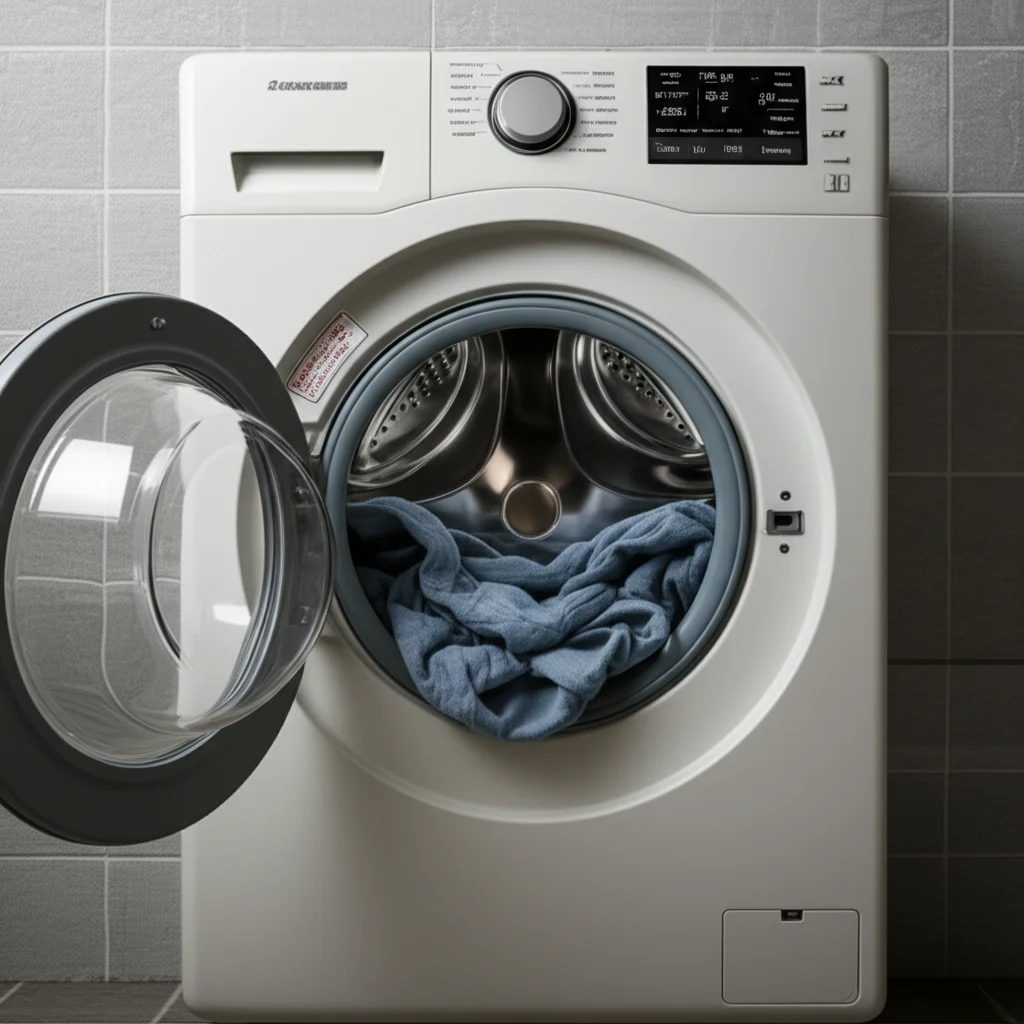· Davia Murnell · Appliance Guides · 20 min read
Can Things Get Lost In The Washing Machine

Can Things Get Lost In The Washing Machine? The Truth About Missing Laundry
Have you ever finished a load of laundry only to find a sock, a small coin, or even a hair tie has vanished? It is a common household mystery. Many people believe a “sock monster” lives in the washing machine. I used to think this too, wondering where my single socks went. This article will reveal if things can get lost in the washing machine. We will explore the mechanical pathways inside your appliance. We will also share practical ways to stop items from disappearing. You will learn how to recover missing items and keep your laundry intact.
Takeaway
- Items can get lost inside washing machines: Small items, like socks or coins, can slip into hidden spaces. These spaces include the drain pump filter, behind the drum, or through faulty seals.
- Prevention is key: Check pockets, use mesh laundry bags for small items, and avoid overloading the machine.
- Regular maintenance helps: Cleaning your washing machine’s filter and inspecting its components can prevent items from getting trapped and improve performance.
- Retrieval is possible: Often, lost items can be recovered by checking accessible parts like the drain pump filter or door gasket.
Yes, Small Items Can Indeed Get Lost Inside a Washing Machine
Small items can get lost in a washing machine. They do not just vanish into thin air. Clothes, coins, or other small objects can slip through small gaps. They might end up in the machine’s internal components. This happens more often than you might think.
The Mystery of Missing Laundry: Do Items Truly Vanish?
We all have tales of laundry disappearing. One sock goes into the wash, but only one comes out. This situation is frustrating and common. It leads many to wonder if a washing machine truly eats clothes. The truth is, items do not simply vanish. They move into parts of the machine where they are not supposed to be.
My own laundry journey has many missing sock stories. I often wonder where the other half of a pair went. It seems like a magic trick. However, the explanation is mechanical, not magical. Small items often find their way into hidden spaces. This happens during the wash cycle’s agitation and spin.
People often assume a mysterious force is at play. This is because they cannot see where the items go. The machine appears sealed and self-contained. Yet, there are tiny gaps and pathways. These allow small objects to escape the main wash drum. Understanding these pathways helps us solve the mystery. It also helps us prevent future disappearances.
It is important to remember that larger items rarely get lost. A sheet or a towel is too big to slip into small openings. It is always the smallest items that disappear. Think about coins, buttons, or those tiny baby socks. These small sizes make them vulnerable to the machine’s internal workings. The force of the water and the spinning action can push them into unexpected places.
This issue is not just about missing socks. Lost items can also cause problems for your washing machine. Coins or hard objects can damage the pump or other parts. This makes prevention even more important. We need to look closely at how these machines work. We will uncover where these items hide.
Understanding the Washing Machine’s Hidden Passages
Your washing machine seems like a simple drum. However, it has many parts and spaces. These areas can become unintended hiding spots for small items. Knowing these hidden passages helps you understand where items go. It also guides you if you need to search for a lost item.
The Inner and Outer Tubs
A washing machine has two tubs. The inner tub is the one you see. It spins and holds your clothes. The outer tub surrounds the inner tub. Water fills the space between these two tubs. Small items, especially during high-speed spinning, can sometimes slip through holes in the inner tub. They then fall into the outer tub. From there, they can travel further down the machine. This is a common path for disappearing items.
The Drain Pump Filter
Most modern washing machines have a drain pump filter. This filter catches lint, debris, and small items. It protects the pump from damage. This filter is often located at the bottom front of the machine. It might be behind a small access door. I always check this filter when something goes missing. It is a prime suspect for lost coins or buttons. Regularly cleaning your washing machine filter is a good habit. This prevents clogs and helps you find lost treasures.
The Door Gasket (Front-Loaders)
Front-loading washing machines have a rubber gasket around the door. This gasket creates a watertight seal. However, this gasket can also collect small items. Socks, hair ties, or even small pieces of laundry can get caught in its folds. This happens during the wash or spin cycle. It is easy to miss these items when unloading. Always check the gasket carefully after each wash. Cleaning the rubber gasket regularly also helps keep it free of debris and potential lost items. You can learn more about this process by visiting our guide on how to clean the rubber gasket in a washing machine.
Under the Agitator (Top-Loaders)
Older top-loading machines often have a central agitator. This part helps move clothes during the wash. Small items can sometimes slip underneath the agitator. They can then get trapped. This area is less accessible. Retrieving items from here might require some disassembly. Modern top-loaders without an agitator still have spaces. These machines use impellers at the bottom. Small items can still get around these.
Hoses and Pipes
Beyond the tubs and filters, items can travel into the hoses. The drain hose leads water out of the machine. It is less common for items to reach this far. If they do, they are likely to cause a clog. Very small, light items might pass through. Larger items will get stuck. This could lead to drainage problems.
Understanding these internal routes demystifies the “lost” phenomenon. It shows that items do not disappear. They just go to places you cannot easily see. Knowing these spots helps you in your search. It also helps you take steps to prevent items from getting there in the first place.
Common Culprits: Items Most Likely to Get Lost
Certain items seem to have a knack for disappearing in the wash. It is not random. Their size, shape, and material make them more prone to slipping away. When I do laundry, I mentally prepare for these usual suspects. Knowing what often gets lost helps me take precautions.
The Elusive Sock
Socks are the most famous vanishing act in laundry. It is almost a cliché. Their small size and light weight make them ideal candidates for escaping the main wash tub. Single socks can easily slip through the tiny gaps. They might get pushed under the agitator. They can also hide within the folds of a front-loader’s gasket. Sometimes, socks even get stuck inside other clothing items, like pillowcases or pant legs. This makes them seem lost. But they are just cleverly hidden.
Small Change and Keys
Many people forget to check pockets before washing. Coins, keys, and even small trinkets are common finds in the washing machine’s internal parts. These metallic items are dense. They can easily fall out of pockets during agitation. Once out, their small size allows them to pass through openings. They often end up in the drain pump filter. These items can also damage your machine. They can scratch the drum or get lodged in moving parts.
Hair Ties and Bobby Pins
Hair accessories are notorious for getting lost. They are tiny and flexible. Hair ties can wrap around parts of the machine. Bobby pins are small metal objects. They can fall into the same hidden spots as coins. These can also cause small scratches or minor damage over time. My own collection of hair ties has dwindled significantly over the years, I suspect many found new homes inside the washer.
Undergarments and Delicates
Small undergarments, like children’s underwear, bras with thin straps, or delicate lace items, are also prone to vanishing. Their light weight and sometimes flimsy structure allow them to get tangled. They can slip into crevices. Bra hooks, in particular, can snag on other clothes or parts of the machine. This can cause damage to both the bra and the washer. Using mesh laundry bags for these items is a simple solution.
Small Toys and Buttons
Parents know the pain of missing small toys. Tiny plastic figures or building blocks sometimes get left in children’s pockets. They then go through the wash. Buttons can also come off clothes during the wash. These small hard objects can cause damage. They can block the drain pump. They can also scratch the inside of the drum.
Understanding these common lost items helps us predict potential disappearances. It encourages a more careful approach to preparing laundry. A quick pocket check and using a laundry bag can save you from future headaches. It also protects your machine from harm.
Beyond the Myth: Real Reasons Clothes Disappear
The idea of a “sock monster” is fun, but real mechanical reasons explain lost laundry. It is not magic. It is physics and machine design. When items disappear, it is usually due to these practical factors. I learned this through years of doing laundry and seeing what actually happened.
Vibrations and Centrifugal Force
Washing machines shake and spin with great power. This movement creates intense vibrations. These vibrations can dislodge items from pockets or from the laundry load itself. During the spin cycle, powerful centrifugal force pushes clothes against the drum’s walls. This force can push small, loose items through tiny holes. They might then enter the space between the inner and outer tubs. This is a primary way small objects escape the main washing area.
Small Gaps and Crevices
Despite being sealed, washing machines have small gaps. These gaps exist between the moving parts and stationary sections. For example, there are tiny spaces around the agitator in top-loaders. There are also small clearances around the drum. These spaces are often big enough for a button, a coin, or a folded-up sock to squeeze through. Once an item enters these gaps, it can then fall into less accessible areas like the drain pump or beneath the outer tub.
Faulty Seals or Gaskets
Over time, the rubber seals and gaskets in your washing machine can wear out. They might become brittle or develop small tears. A damaged door gasket on a front-loader can allow items to slip past it. This lets them enter the machine’s internal workings. A worn seal around the drum can also create a pathway for items to escape. Regular inspection of these seals is important. This prevents both water leaks and lost items.
Overloading the Machine
Putting too many clothes into the washing machine is a common mistake. An overloaded machine does not allow clothes to move freely. This means some items might get trapped. They can get pushed against the drum walls with excessive force. This increases the chance of small items being forced through openings. It also puts more strain on the machine’s components. Always follow the manufacturer’s guidelines for load size. This ensures proper cleaning and prevents items from being forced into tight spaces.
Damage to Clothing Items
Sometimes, the item itself is at fault. If a sock has a hole, a button is loose, or a seam is frayed, it is more likely to break apart. Small pieces can then detach and become lost. A delicate item might snag and tear. This allows small parts of it to escape. Inspecting clothes for damage before washing helps. Repairing small tears can prevent larger issues. It also keeps your laundry intact.
By understanding these real reasons, we can take better steps to prevent items from disappearing. It moves us away from mythical explanations. It empowers us to be more effective at laundry care.
Proactive Measures: Preventing Lost Laundry
Stopping items from getting lost is easier than trying to find them later. A few simple habits can make a big difference. I have found that a little effort before washing saves a lot of frustration later. These tips help keep your laundry intact. They also protect your washing machine.
Check All Pockets Thoroughly
This is perhaps the most important step. Before putting any item into the washer, check every pocket. This includes jeans, jackets, shirts, and even pajamas. Coins, tissues, pens, and small toys are common pocket dwellers. They can easily fall out during the wash. My family knows I always ask, “Did you check your pockets?” It saves us from many lost items and potential machine damage.
Utilize Mesh Laundry Bags for Small Items
Mesh laundry bags are your best friend for small or delicate items. Put socks, underwear, baby clothes, hair ties, or any other tiny items into a mesh bag. The bag keeps them together throughout the wash cycle. It prevents them from slipping through gaps. It also protects delicate items from tangling or stretching. I use them for all my socks now. This has drastically reduced my missing sock count.
Repair Loose Buttons and Hems
Inspect your clothing for loose buttons, frayed hems, or small tears. Buttons can come off during agitation and end up in the machine’s components. Frayed fabric can unravel, leaving small threads or pieces behind. A quick repair before washing can prevent these small parts from escaping. It also extends the life of your clothes.
Avoid Overloading the Washing Machine
Overloading is a common mistake. It does not clean clothes effectively. It also increases the risk of items getting lost. When the machine is too full, there is not enough space for water and detergent to circulate properly. Clothes get packed tightly. This force can push small items through the drum’s perforations. Follow your machine’s guidelines for load size. You should be able to place your hand into the drum and move it around comfortably above the clothes.
Regular Washing Machine Maintenance
A well-maintained washing machine is less likely to lose items. Regularly cleaning your washing machine helps remove buildup. This prevents parts from wearing down prematurely. Pay special attention to the drain pump filter and the door gasket.
- Clean the Drain Pump Filter: This filter catches debris. A clogged filter can prevent water from draining properly. It can also hold onto lost items. Check and clean it every few months. Our guide on how to clean your washing machine’s filter provides detailed steps.
- Inspect and Clean the Gasket: For front-loaders, regularly wipe down the rubber gasket. Look for any tears or trapped items. Cleaning mold from the gasket also improves its integrity. You can find useful tips on how to clean mold from a washing machine in our comprehensive guide.
By adopting these proactive habits, you can significantly reduce the number of items that go missing. You will also extend the lifespan of your washing machine. These simple steps make laundry day less mysterious and more efficient.
The Search Party: How to Recover Lost Items
When an item goes missing, all hope is not lost. Many vanished items can be recovered. Knowing where to look increases your chances. It requires a bit of detective work and sometimes some patience. I have had success finding items in unexpected places.
Check the Door Gasket (Front-Loaders)
This is the first place I always look for a missing sock or small garment. The rubber gasket around the door of front-loading machines has folds and crevices. Small items often get caught there. Pull back the folds of the gasket carefully. Run your hand around the entire circumference. You might be surprised by what you find. This area is easily accessible and often holds missing treasures.
Inspect the Drain Pump Filter
The drain pump filter is designed to catch lint, debris, and small objects. It is a common hiding spot for coins, buttons, and even small socks. The filter is usually located at the bottom front of your washing machine. It might be behind a small access panel or a kick plate. Before opening, place a shallow pan or towels underneath. Some water will likely drain out. Unscrew the cap slowly to release any trapped water. Then, pull out the filter and inspect it thoroughly. I have found many lost coins here. Remember, regular cleaning of your washing machine’s filter prevents clogs and helps with discovery.
Look Under and Behind the Machine
Sometimes, items do not go into the machine, but out of it. Intense vibrations during the spin cycle can cause lightweight items to “walk” off the top of the machine. They might fall behind or underneath it. Check the floor directly under and behind your washing machine. Also, look under any laundry baskets or cabinets near the washer. My cat once pulled a sock off the top of the machine, making it “disappear.”
Examine the Hoses
If you suspect an item has gone further into the drainage system, check the hoses. This is more difficult and usually requires disconnecting the machine. The drain hose, which empties water from the washer, can sometimes get clogged by larger lost items. This is less common for typical “lost” items like socks but can happen with coins or smaller toys. If your machine is having drainage issues after something disappeared, this might be the culprit. If you are unsure, it is best to call a professional for this step.
Consider Calling a Professional
If you have tried all accessible methods and an item is still missing, it might be stuck deeper inside the machine. This could be between the inner and outer tubs. It could also be wrapped around the agitator shaft. For these situations, disassembling the washing machine is often necessary. This requires specialized tools and knowledge. Attempting this yourself without proper experience can damage your appliance. In such cases, it is wise to call a qualified appliance repair technician. They can safely open the machine and retrieve the item.
Patience is key during your search. Do not rush the process. A thorough check of these common hiding spots will often lead to a happy reunion with your lost laundry.
The Unseen Impact: Frustration and Appliance Health
Missing laundry items are more than just a minor inconvenience. They can cause real frustration. They also pose potential risks to your washing machine’s health. I know the feeling of finding only one sock. It feels like a small theft in my own home. Understanding these impacts highlights why prevention and recovery are important.
The Psychological Toll of Missing Socks
The “sock monster” phenomenon is a running joke in many households. Yet, there is a real psychological element to it. It is frustrating to have incomplete pairs. It makes you feel disorganized. It creates a sense of minor helplessness against a seemingly invisible force. I often find myself holding up a single sock, wondering about its lost partner. This small frustration adds up over time. It makes laundry feel like a chore with an unpredictable outcome. It can even lead to unnecessary purchases of new socks or undergarments.
Potential Damage to Your Washing Machine
Beyond emotional distress, lost items can cause physical harm to your appliance. This is a more serious concern.
- Drain Pump Clogs and Damage: Small, hard items like coins, buttons, or small toys can clog the drain pump filter. If they bypass the filter, they can damage the pump itself. A damaged pump prevents your machine from draining water. This leads to costly repairs.
- Scratches and Dents: Metallic objects or hard plastic items can bounce around inside the drum. They can scratch the drum’s surface. While often cosmetic, deep scratches can sometimes lead to rust over time.
- Hose Blockages: Items that escape the drum and filter can end up in the drain hoses. This creates blockages. A blocked hose stops water from leaving the machine. This can cause leaks or even overflow.
- Bearing and Seal Wear: Items lodged in the space between the inner and outer tubs can interfere with the machine’s moving parts. They might cause extra friction or imbalance. This can accelerate wear on bearings and seals. This leads to louder operation or even total machine failure.
- Agitator or Impeller Issues: In top-loaders, items can get caught under or around the agitator or impeller. This can strain the motor. It can also damage these components.
Preventing items from getting lost protects your peace of mind. It also safeguards your valuable washing machine. Regular checks, using laundry bags, and following load guidelines are small efforts. These efforts prevent big problems. By being proactive, you can ensure your laundry cycles are efficient. You can also ensure your machine stays healthy for longer. This saves you money on repairs and reduces daily annoyances.
Frequently Asked Questions
Can a sock really go inside the wall of a washing machine?
A sock cannot go into the wall of a washing machine. It can slip into the space between the inner and outer tubs. From there, it may travel to the drain pump filter. It cannot leave the sealed washing machine unit. Any item remains within the machine’s internal system.
How do I know if something is stuck in my washing machine?
You might notice unusual noises like rattling or grinding during a cycle. The machine might also vibrate excessively. Drainage problems or an odd smell can also signal a trapped item. If your machine is not draining properly, something might block the drain pump or hose.
Can a lost coin damage my washing machine?
Yes, a lost coin can damage your washing machine. Coins are heavy and metallic. They can scratch the drum. More seriously, they can get lodged in the drain pump. This can cause the pump to break. Always check pockets to prevent this type of damage.
How often should I clean my washing machine filter to prevent lost items?
You should check and clean your washing machine’s drain pump filter every 2-3 months. If you wash many heavily soiled items or pets’ bedding, clean it more often. Regular cleaning prevents clogs. It also helps you find any small items that have collected there.
What should I do if my washing machine smells bad after a missing item?
A bad smell, especially a rotten egg smell, suggests stagnant water or mold. This might happen if a lost item is rotting inside. First, clean your drain pump filter. Then, run a cleaning cycle with a washing machine cleaner or vinegar. Our guide on how to clean a smelly washing machine offers detailed solutions.
Is it possible to retrieve items stuck between the tubs?
Retrieving items stuck between the inner and outer tubs is very difficult. It usually requires partial disassembly of the washing machine. This job is best left to a professional appliance repair technician. Attempting it yourself can damage the machine.
Conclusion
The mystery of missing laundry is a common household puzzle. But the answer to “can things get lost in the washing machine” is yes, small items truly can. They do not vanish into another dimension. Instead, they find their way into hidden mechanical spaces. These spaces include the drain pump filter, the door gasket, or the area between the tubs. Understanding these pathways helps demystify the problem.
We have explored the usual suspects, like socks and coins. We also looked at the real reasons behind their disappearance, from machine vibrations to worn seals. Most importantly, we covered practical steps to prevent these laundry disappearances. Checking pockets, using mesh bags, and performing regular machine maintenance are simple yet effective habits. When items do go missing, checking accessible spots like the drain filter or door gasket often leads to success. If the item is deeper, a professional can help.
By being mindful and proactive, you can save yourself frustration. You can also protect your washing machine from potential damage. So, the next time you do laundry, remember these tips. Keep your clothes together, and keep your machine running smoothly. Do not let the “sock monster” win another battle. Take control of your laundry routine today and ensure all your items complete the wash cycle.





